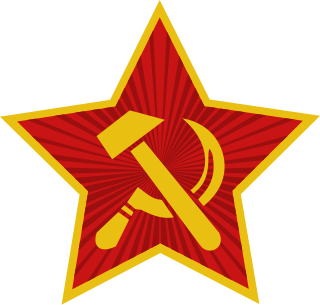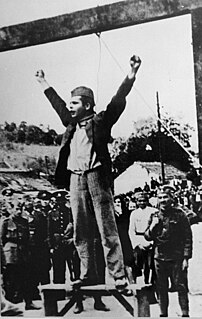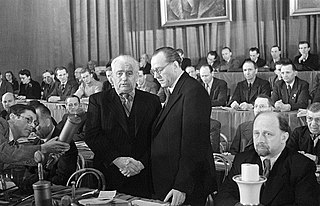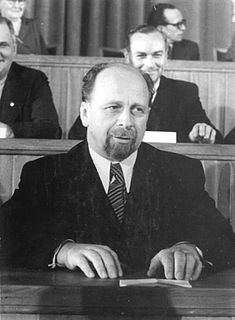 W
WThe Communist Party of Germany was a major political party in the Weimar Republic between 1918 and 1933, an underground resistance movement in Nazi Germany, and a minor party in West Germany in the postwar period until it was banned by the Federal Constitutional Court in 1956.
 W
WThe Murders of Paul Anlauf and Franz Lenck were a double homicide that took place in Berlin, Germany on 9 August 1931, when police captains Paul Anlauf and Franz Lenck were assassinated by the paramilitary wing of the Communist Party of Germany (KPD). Both Anlauf and Lenck were members of the Social Democratic Party of Germany (SPD). One of the murderers, Erich Mielke, later became the head of the Stasi, the secret police of East Germany, and it was only in 1993 that he was tried and convicted of the murders.
 W
WAntifaschistische Aktion was a militant anti-fascist organisation in the Weimar Republic started by members of the Communist Party of Germany (KPD) that existed from 1932 to 1933. It was primarily active as a KPD campaign during the 1932 German federal elections and was described by the KPD as a "red united front under the leadership of the only anti-fascist party, the KPD."
 W
WBadisches Volksecho was a German language weekly newspaper. It was published from Stuttgart, West Germany between April 1946 and March 1947. Later it was published from Mannheim, Karlsruhe and Stuttgart, West Germany between April, 1947 to August 11, 1956. It was published by the regional organization of the Communist Party of Germany in Württemberg-Baden. Albeit initially planned as an organ for northern Baden, it became distributed in the French occupation zone as well after the banning of the south Baden organ Unser Tag.
 W
WBlutmai refers to the 1929 killing of 33 Communist Party of Germany (KPD) supporters and uninvolved civilians by the Berlin Police over a three-day period, after a KPD International Workers' Day celebration was attacked by police. In defiance of a ban on public gatherings in Berlin, the KPD had organized a rally to celebrate May Day. Although fewer supporters rallied than the KPD had hoped, the response by the police was immediate and harsh, using firearms against mostly unarmed civilians. During the three days of rioting that followed, 33 civilians were murdered, around 200 injured, and over a thousand taken into police custody. One policeman was injured. The event was a significant moment in the decline of the Weimar Republic and its political stability. The incident also marked a turning point in relations between the centre-left SPD government and the far-left Moscow-aligned KPD, weakening any prospect of a united left-wing opposition to fascism and the rising National Socialist German Workers Party. The brutality of the police's response also led to a further erosion of public trust in the government.
 W
WDeutsche Volkszeitung was a newspaper published daily from Berlin, Germany between 1945-1946. It was the organ of the Central Committee of the Communist Party of Germany (KPD).
 W
WThe March Action (German "März Aktion" or "Märzkämpfe in Mitteldeutschland" was a 1921 failed Communist uprising, led by the Communist Party of Germany, the Communist Workers' Party of Germany, and other far-left organisations. It took place in the industrial regions located in Halle, Leuna, Merseburg, and Mansfeld. The revolt ended in defeat for the Communists, and a weakening of contemporary Communist influence in Germany.
 W
WThe Communist Party of Germany (KPD) and the Social Democratic Party of Germany (SPD) merged to form the Socialist Unity Party of Germany (SED) on 21 April 1946 in the territory of the Soviet occupation zone. It is considered a forced merger. In the course of the merger, about 5,000 Social Democrats who opposed it were detained and sent to concentration camps and jails.
 W
WMezhrabpomfilm, from the word film, and the Russian acronym for Workers International Relief or Workers International Aid, was a German-Russian film studio, formerly Mezhrabpom-Rus, from 1922-1936. The studio was formed from the joining together in 1922 of Moisei Aleinikov, a Russian producer, and Willi Münzenberg, a German communist. The studio was set up in Moscow, with headquarters in Berlin. After producing around 600 films the "international experiment was brutally ended eleven and fourteen years later by Hitler's and Stalin's regimes."
 W
WThe National Committee for a Free Germany was a German anti-Nazi organization that operated in the Soviet Union during World War II.
 W
WThe Rote Hilfe was the German affiliate of the International Red Aid. The Rote Hilfe was affiliated with the Communist Party of Germany and existed between 1924 and 1936. Its purpose was to provide help to those Communists who had been jailed or were imprisoned.
 W
WThe Roter Frontkämpferbund, usually called Rotfrontkämpferbund (RFB), was a far-left paramilitary organization affiliated with the Communist Party of Germany (KPD) during the Weimar Republic. It was officially a non-partisan and legally registered association. The organisation was banned as extremist by the governing Social Democrats in 1929.
 W
WThe Spartacus League was a Marxist revolutionary movement organized in Germany during World War I. The League was named after Spartacus, leader of the largest slave rebellion of the Roman Republic. It was founded by Karl Liebknecht, Rosa Luxemburg, Clara Zetkin, and others, their goal being an international proletarian revolution in order to overthrow capitalism, imperalism and militarism worldwide. The League subsequently renamed itself the Kommunistische Partei Deutschlands (KPD), joining the Comintern in 1919. Its period of greatest activity was during the German Revolution of 1918, when it sought to incite a revolution by circulating the newspaper Spartacus Letters.
 W
WThe Ulbricht Group was a group of exiled members of the Communist Party of Germany, led by Walter Ulbricht, who flew from the Soviet Union back to Germany on April 30, 1945. Composed of functionaries from the KPD and ten anti-fascist prisoners of war, their job was to seek out anti-fascist individuals and prepare the groundwork for the re-establishment of communist organizations and unions in postwar Berlin. There were two additional regional groups, the Ackermann Group in Saxony and the Sobottka Group in Mecklenburg. Many of the group's members later became high-level officials in the government of the German Democratic Republic (GDR).
 W
WThe Young Communist League of Germany was a political youth organization in Germany.